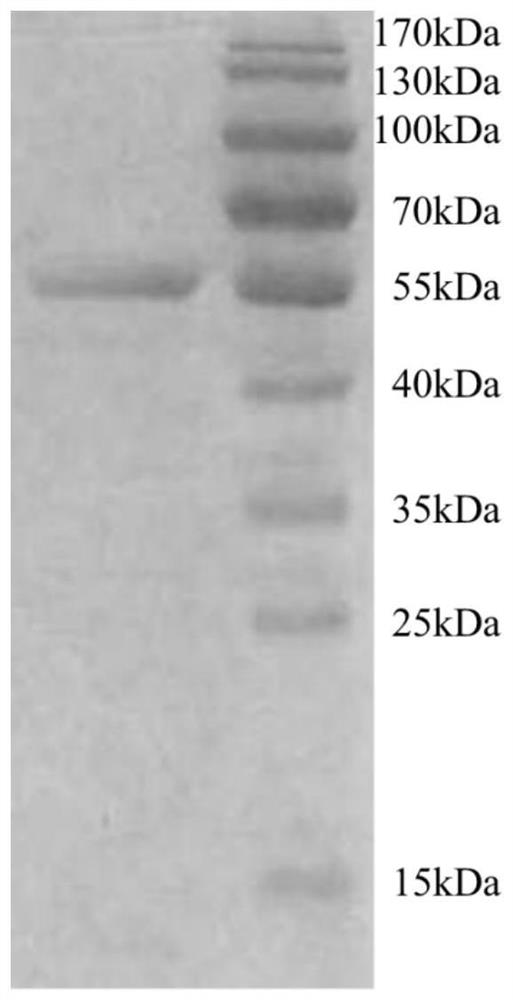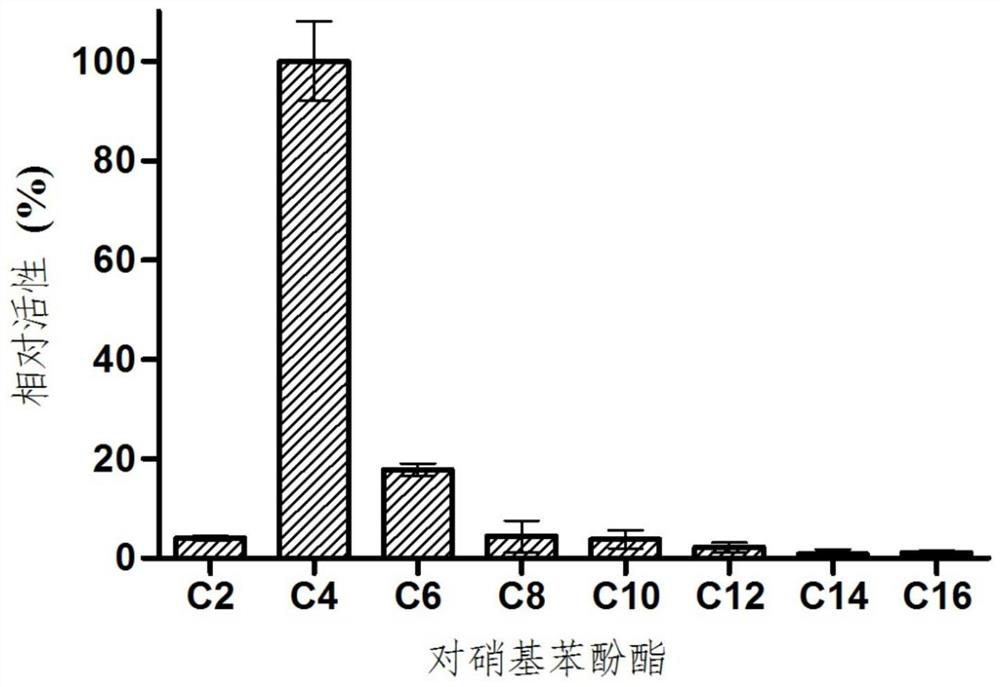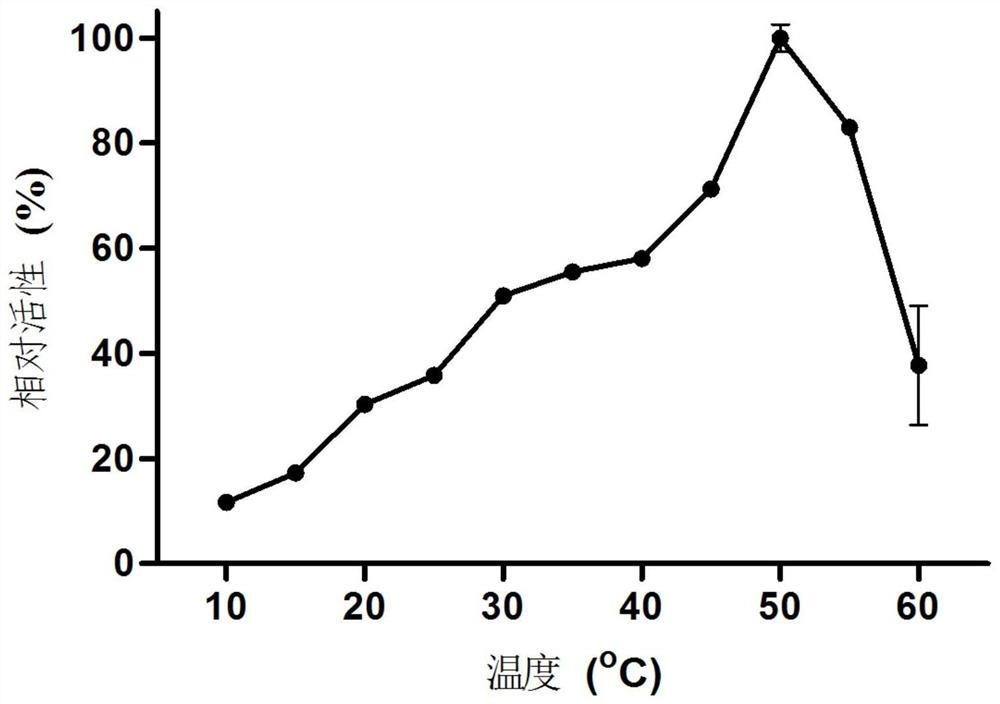A novel deep-sea thermostable alkaline esterase and its application
An esterase, alkaline technology, applied in the field of genetic engineering
- Summary
- Abstract
- Description
- Claims
- Application Information
AI Technical Summary
Problems solved by technology
Method used
Image
Examples
Embodiment 1
[0024] The acquisition of embodiment 1 esterase gene e6
[0025] Based on deep-sea sediment-derived bacteria Croceicoccus marinus E4A9 TWhole genome, open reading frame prediction and gene annotation results to screen lipid hydrolase-related genes. Sequences were aligned by Blastx (http: / / blast.ncbi.nlm.nih.gov / ) for homology to known esterase gene sequences in databases. The e6 gene was obtained by database alignment analysis, with a size of 1338 bp and a base composition of 204A (15.25%), 206T (15.40%), 464C (34.68%) and 464G (34.68%). Its nucleotide sequence is as shown in SEQ ID No. :1 shown. The size of the encoded protein is 445 amino acid residues, and its amino acid sequence is shown in SEQ ID No.2. The gene sequence was searched for homology in GenBank, and the highest similarity was the esterase in the same family (Erythrobacteraceae) bacteria Erythrobacter sp.QSSC1-22B, the similarity was 63%, which was in the GenBank database The registration number is OBX19645...
Embodiment 2
[0028] Example 2 Construction of recombinant expression plasmid and recombinant strain of esterase gene e6
[0029] The esterase gene e6 obtained by the present invention is cloned into an expression vector to construct a recombinant expression strain. Based on the open reading frame sequence of the esterase gene obtained by the ORF analysis of NCBIORF Finder, the upstream primer E6F (5'-TCGC) to amplify the whole esterase gene was designed. GGATCC ATGCCGCCTTCGCCCAC-3', BamHI) and downstream primer E6R (5'-TCCG CTCGAG CTAGTTGCTGGCGGTTTCCTC-3', XhoI), PCR amplification confirmed the full-length sequence of the gene. The expression plasmid was constructed by the method of enzyme digestion and cloning, that is, the PCR product was double-digested with BamHI and XhoI, and the purified fragment was ligated with the plasmid pSMT3 double-digested by BamHI and XhoI, using CaCl 2 Transform into E.coli DH5α, and select positive clones for kanamycin resistance. Plasmids of positive ...
Embodiment 3
[0030] Embodiment 3 utilizes recombinant expression strain to express recombinant esterase gene e6
[0031] Transfer 3 ml of the constructed recombinant expression strain to 100 ml of LB liquid medium containing 20 μg / ml kanamycin and 34 μg / ml chloramphenicol, and culture with shaking at 37°C to OD 600 When it reached 0.6, IPTG was added with a final concentration of 0.5 mM to induce expression, and then it was transferred to 25°C for 8 hours with shaking at 150 r / min. The cells were collected by low-temperature centrifugation, resuspended in NTA-10 solution (500 mM sodium chloride, 10 mM imidazole, 20 mM Tris hydrochloric acid, pH 8.0), and sonicated on ice. The supernatant was collected by cryogenic centrifugation, using NTA-Ni 2+ The expressed protein was purified by affinity column chromatography. The expressed recombinant protein contains 6×His tag at the N-terminus, which can be affinity adsorbed to the layer suction column, and the eluate is collected by gradient elut...
PUM
| Property | Measurement | Unit |
|---|---|---|
| absorbance | aaaaa | aaaaa |
Abstract
Description
Claims
Application Information
 Login to View More
Login to View More - R&D
- Intellectual Property
- Life Sciences
- Materials
- Tech Scout
- Unparalleled Data Quality
- Higher Quality Content
- 60% Fewer Hallucinations
Browse by: Latest US Patents, China's latest patents, Technical Efficacy Thesaurus, Application Domain, Technology Topic, Popular Technical Reports.
© 2025 PatSnap. All rights reserved.Legal|Privacy policy|Modern Slavery Act Transparency Statement|Sitemap|About US| Contact US: help@patsnap.com



